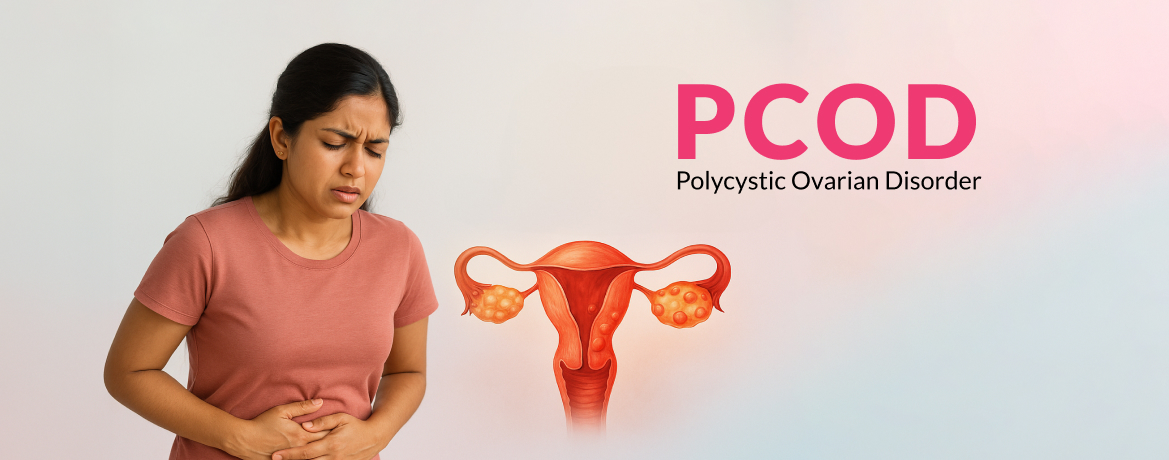What is PCOD (Polycystic Ovarian Disorder)?
An imbalance of hormones causes PCOD. This disorder will affect the functioning of the ovaries. The woman with this disorder will have high levels of male hormones (androgens). As a result of these hormones, small cysts develop on the ovaries. This may lead to irregular periods or absence of periods in women. It depends on environmental, lifestyle, and hereditary variables. It affects about 5-7% of women aged from 12 to 45, with 9%-22% prevalence in India.
What are the signs and symptoms of PCOD?
- Irregular or Absent Periods: This is a common symptom, which means the menstrual cycles in a woman are longer than 35 days. Some women have fewer than eight periods a year, or a complete absence of periods.
- Heavy or Prolonged Periods: Some women have heavy bleeding during their periods.
- Acne: Women with hormonal imbalance and high androgen levels often have severe acne.
- Excess Hair Growth: Women with high androgens may notice extra hair on their face, chin, chest, abdomen, and back.
- Weight Gain: Insulin resistance can lead to weight gain.
- Skin pigmentation: Dark patches appear in skin folds, like the neck, groin, and underarms. These patches are often linked to insulin resistance.
- Hair loss: Increased androgens can sometimes lead to thinning hair on the scalp.
- Difficulty getting pregnant: If a woman doesn’t ovulate regularly or at all, it can be hard to get pregnant naturally.
What are the main causes of PCOD in females?
The cause of PCOD in women can differ from one person to another. This results in a variety of symptoms and levels of severity.
- Hormonal Imbalance: This is the primary cause of PCOD. High levels of androgens, like testosterone, can affect egg growth and release. This can lead to hirsutism (extra body hair) and acne. In PCOD, balancing Luteinizing Hormone (LH) and Follicle-Stimulating Hormone (FSH) is important. An imbalance can disrupt ovulation. This affects how eggs mature and are released.
- Insulin Resistance: About 70% of women have insulin resistance. This means the body’s cells don’t respond well to insulin. Insulin is a hormone that controls blood sugar. High insulin levels can cause the ovaries to make more androgens. This can lead to a hormonal imbalance that elevates the risk of PCOD. Insulin resistance can also contribute to weight gain, which can worsen PCOD.
- Genetics: A woman with a family history of PCOD has a higher risk of developing it.
- Low-Grade Inflammation: Women with PCOD tend to have higher levels of chronic, low-grade inflammation. This inflammation can cause the ovaries to make more androgens. This can lead to a hormonal imbalance.
- Lifestyle Factors: Some lifestyle choices can greatly affect PCOD. For instance, an unhealthy diet, not getting enough exercise, and constant stress can make symptoms worse. They raise insulin resistance. Additionally, weight gain and stress can change hormone levels, leading to PCOD.
Role of Hormones in PCOD
The hormones that play an important role in the development of PCOD are:
- Androgens: High androgen levels in women can lead to more body hair, acne, and male-pattern baldness.
- Insulin: Many women with PCOD have insulin resistance (Body cannot use insulin effectively). This results in high levels of insulin that raise the androgen production.
- Luteinizing Hormone (LH) and Follicle-Stimulating Hormone (FSH): These hormones help to regulate ovulation. In a woman with PCOD, these hormones are imbalanced, leading to irregular ovulation.
Diagnosis of PCOD (Polycystic Ovarian Disease)
Diagnosis is typically based on a combination of factors, including:
- Medical History: The Doctor will review the frequency of menstrual cycles. They will check how often they happen, any symptoms of PCOD, and the patient’s family history of menstrual problems.
- Physical Examination: This includes looking for signs of high androgen levels. These signs can cause excess body hair and acne in the patient.
- Ultrasound: The doctor examines the patient’s pelvis with an ultrasound. This shows the size of the ovaries, any cysts present, and the condition of the reproductive organs.
- Blood Tests: These tests check hormone levels. They include androgens, LH, FSH, and sometimes insulin and glucose.
PCOD Risks and Complications
- Endometrium: There is a higher risk of endometrial hyperplasia. This means the uterus lining thickens. Sometimes, this can lead to endometrial cancer.
- Mental health issues: Hormonal changes can increase the risk of anxiety and depression.
- Pregnancy complications: Increased risk of infertility, gestational diabetes, preeclampsia, and preterm birth.
Treatment for Polycystic Ovarian Disease (PCOD)?
PCOD can be successfully treated to increase fertility, decrease long-term health risks, and relieve symptoms. Treatment plans will be customised based on the severity of symptoms and the health condition of the patient. Let us discuss the available options:
Medication and Surgical Treatment Options for PCOD
- Hormonal Birth Control (Oral Contraceptives): These are prescribed to regulate menstrual cycles, reduce androgen levels, and manage acne and excess hair growth in women with PCOD.
- Anti-Androgen Medications: These medicines block the effects of excess androgens, reduce hirsutism (excess body hair growth), and acne.
- Medicines for Diabetes: These are advised to treat type 2 diabetes and improve insulin sensitivity in women with PCOD.
- Medications to Induce Ovulation: For some women with PCOD, can be improved by prescribing medications such as metformin, letrozole, clomiphene citrate, gonadotropins, and injections of FSH and LH that promote ovulation.
Surgical Options
- Ovarian Drilling: Although laparoscopic ovulation puncture is not a first-line treatment, it can temporarily lower testosterone levels and improve ovulation in certain women who have not responded to medication.
- Assisted Reproductive Technologies (ART): IVF is recommended for women with PCOD who haven’t conceived with other fertility treatments, which involves retrieving eggs from the ovaries, fertilizing them in a lab, and transferring the embryos to the uterus.
PCOD Management by Lifestyle Changes
Lifestyle changes, especially diet and exercise, are significant for managing Polycystic Ovarian Disease (PCOD).
Diet for PCOD
- Low glycaemic Index foods
- Fruits and leafy vegetables
- Fiber-rich foods
- Nuts and whole grains
- Lean meat and fish
- Low-fat food
- Unprocessed foods
Exercises for PCOD
- Cardiovascular Exercise: Brisk walking, jogging, cycling, and swimming.
- Strength Training: Weightlifting and bodyweight exercises
- Mind-Body Exercises: Yoga, meditation, and deep breathing exercises.
What are the differences between PCOD and PCOS?
PCOD (Polycystic Ovarian Disease) and PCOS (Polycystic Ovary Syndrome) are two conditions that are related but not the same. Both impact women’s reproductive health. They have some similarities, but key differences are important for proper diagnosis and treatment. Let us discuss the differences between PCOD and PCOS. It covers their causes, symptoms of PCOS, and ways to manage the condition.
PCOD is different when compared to PCOS in the following points
- It is more common than PCOS.
- It can be conceived naturally with lifestyle adjustments or minimal medical help.
- It has a low impact on metabolic health, and insulin resistance is not common.
- It has less severity associated with long-term health risks compared to PCOS.
- It is strongly associated with metabolic syndrome, including insulin resistance, type 2 diabetes, and high blood pressure.
PCOD vs PCOS: Key Differences
| Feature | PCOD (Polycystic Ovarian Disease) | PCOS (Polycystic Ovary Syndrome) |
| Primary feature | Primarily an issue with the ovaries and egg maturation, leading to the growth of cysts. | A syndrome characterized by high androgen levels, issues with insulin, and ovarian cysts. |
| Hormonal Imbalance | The conditions were milder and primarily influenced egg production and release. | It features high androgen levels, which are often linked to insulin resistance. |
| Impact on Periods | Often irregular, but periods may still occur. | Very irregular periods, missed periods, or heavy bleeding are common. |
| Severity | Generally considered a milder condition. | Considered a more complex hormonal and metabolic disorder. |
| Cyst characteristics | Multiple small cysts on the ovaries, but the ovarian volume may be normal. | Many small cysts on the ovaries usually come with a larger ovarian size. |
| Long-term Health Risks | Typically, the conditions are less severe and primarily related to irregular cycles. | Increased chances of:Type 2 diabetes, High blood pressure, High cholesterol, Heart disease, Sleep apnea, and Endometrial cancer. |
| Management | Often manageable with lifestyle changes. | Usually requires a combination of lifestyle changes and medical treatment. |
Summary
Although managing PCOD might be difficult, there are useful management techniques and treatments. Discussing the problem with doctors will help to identify symptoms and understand the fundamentals of PCOD. Medical interventions and a healthy lifestyle can help the individual to improve symptoms, lower long-term health risks, and support the success of personal goals to have kids.
Our Clinic Locations
Andhra Pradesh
PCOD Treatment in Visakhapatnam | PCOD Treatment in Vijayawada | PCOD Treatment in Rajahmundry | PCOD Treatment in Tirupati | PCOD Treatment in Kurnool
Telangana
PCOD Treatment in Kukatpally | PCOD Treatment in Lb Nagar | PCOD Treatment in Secunderabad | PCOD Treatment in Banjara Hills | PCOD Treatment in Karimnagar | PCOD Treatment in Warangal
FAQ's



